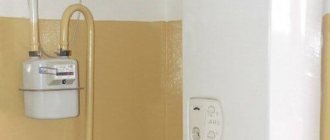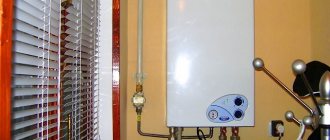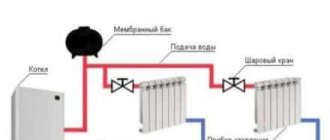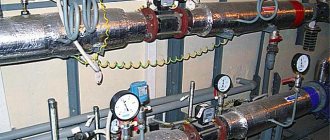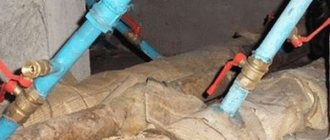The presence of central heating in the apartment is, of course, convenient, since the owners “don’t have a headache” in this regard. But, unfortunately, this is not always practical, since the temperature in the rooms begins to directly depend on the thermal regime established in the common boiler room. In addition, such a system is not insured against emergency situations that can occur along any part of its length, as a result of which the entire house is often turned off from heating. Many difficulties also arise during the “off-season” periods, when early cold weather arrives ahead of the planned start of the heating season, or, conversely, the radiators are heated when the weather outside is too warm.
Despite temperature violations and temporary heating shutdowns at home, payment for it remains unchanged, which is absolutely not beneficial for ordinary users. Therefore, in recent years, a trend has been gaining momentum when more and more owners of apartments in high-rise buildings are resorting to installing autonomous heating systems.
Individual heating in an apartment building - necessary documents and installation rules
Those who decide to “separate”, as a rule, have numerous questions related to various nuances of this procedure. Therefore, further we will consider individual heating in an apartment building - the necessary documents and installation rules for it.
How many approvals do you need to collect?
For individual heating, the apartment needs to be redesigned. Both the destruction of walls and partitions and their construction consist of a labor-intensive process. It will take a long time to receive each completed paper. It is necessary to take into account installation work and the purchase of materials, so reconstruction begins with the preparatory stages:
- determined with the collection of a documentary package;
- develop a project;
- purchase equipment;
- install an autonomous system.
The regulation for any redevelopment is the Housing Code of the Russian Federation, Article 26. The reconstruction of residential premises is carried out according to technical requirements; each stage of work must be agreed with the local government. To contact the regional authority, you need to collect documents that will serve as an appendix to the main application.
General documentary support for the submitted application, filled out according to the standard form:
- title documentation - this can be a certificate of ownership, transfer of an apartment by inheritance, a purchase and sale agreement;
- photocopy of technical passport;
- redevelopment of an apartment in the project;
- information about all registered persons in the residential area;
- written notarial consent of each registered person;
- confirmation that the building is not an architectural monument.
Redevelopment may be refused if it worsens the condition of the house or threatens the safety of residents. Project documentation for autonomous heating is coordinated with authorized organizations from the field of gas and heat supply.
To disconnect the heating circuit in an apartment from the general system, you need to obtain permission from the city or regional heating networks. Specialists of this level will agree to an agreement provided that the installations do not disrupt the functionality of the building's utilities and equipment. Only a security threat can lead to the refusal of a request for heating autonomy. Applications for an individual heating system are accepted by the housing management organization.
Actions consist of the following steps:
- receive a consent letter;
- contact the gas service;
- receive technical specifications;
- take apartment property documents;
- order a project;
- purchase equipment that meets the specifications.
SNiP41-01-2003 contains the basic requirements for heating and ventilation devices. You can be exempt from registration by concluding an agreement with an organization that provides such services.
Obtaining a permit depending on the type of energy carrier
In 2012, Government Decree No. 307 was issued, which considered the legal procedure for connecting devices to supply heat to apartment buildings. The legal order establishes requirements for devices and prohibitions for installing equipment that does not meet technical conditions.
For example, gas boilers must meet the requirements:
- the combustion chamber is hermetically sealed;
- the fuel supply is automatically turned off;
- the carrier temperature does not exceed 90 degrees, with a pressure of up to 1 MPa.
When submitting an application for permission to disconnect from the general heating supply, indicate the type of boiler: single-circuit or double-circuit. Permits are obtained for both heating and hot water. The owner chooses a wall-mounted or floor-mounted boiler design.
The owner of the apartment will have to arrange a room that meets the following conditions:
- the room should not be residential;
- 4 sq.m. - square;
- 8 m – width of the entrance door;
- a window opening facing the street was cut through;
- equipped with a chimney;
- a ventilation structure has been installed.
Electric heating does not have such strict installation requirements. They install devices in any convenient place. This equipment does not require separate ventilation to remove combustion products, and power points are located in each room. The layout is approved by Energonadzor, the organization’s employees calculate additional sources, and allocate the power line of the required power.
Local heating networks and energy companies will provide their list of necessary documentation for connecting the boiler. Each district has established local requirements for equipment and installation. They are directly responsible to the executive branch and the law if an emergency occurs.
Electric heating can be using:
- units in which there is a normal pipe layout where the coolant circulates;
- direct heating devices, electrical systems, convectors, heaters.
When coolant is used, the piping to the radiators is not touched. They are connected to electric boilers, from which the coolant is heated instead of heating heating lines. Such units operate in an automatic heating system.
When heated, coolants from water or antifreeze pass through:
- boiler;
- heating circuit;
- radiators;
- cooling of the liquid;
- return and repetition of the cycle.
About the legal possibility of disconnecting from centralized heating services and installing autonomous (individual) heating in an apartment building in the following video:
11 Apr 2022 Yulia Yurievna 36
Individual heating of an apartment: what is it, why and what for
Most often, people decide to abandon general heating due to the fact that:
- they are not satisfied with the quality of heating - lack of heat, discomfort in the cold season
- they want to regulate the level and timing of heat supply to the apartment themselves
- they want to reduce heating bills
In many new buildings, all apartments are initially equipped with an individual heating system, but residents of the old building should not be upset - it is quite possible to switch the apartment to individual heating. To do this, you will have to dismantle the old pipes and radiators, install new ones and connect them to the boiler-heater. The latter will heat the water and drive it through all the pipes, thereby heating the apartment. Hot water can also be connected to this boiler.
By installing his own heating system, the owner of the apartment will get rid of a lot of problems: he will no longer be afraid of planned and unscheduled shutdowns of heat and hot water supply, he will not freeze in severe cold and languish from the heat in the spring, when the sun is already blazing with might and main, but utility services are in no hurry turn off the heat supply. In general, there are a lot of advantages, but there are also quite a few problems. Before you acquire your own heating system, you will have to resolve a lot of issues, both technical and documentary. Let's deal with the technical side first.
Gas or electricity
When planning your own heating system, you need to choose what to heat with - gas or electricity. It is necessary to immediately make a reservation that we are talking about the system of the boiler itself, since the apartment is heated in any case by the liquid circulating through the pipes, but the boiler that heats it can run on both gas and electricity.
There is no doubt that gas boilers are the most popular. Their undeniable advantages are as follows:
- financial savings: gas is the cheapest type of fuel
- can be wall-mounted or floor-mounted - both are quite compact
- independence from electricity - in the event of a power outage, the apartment will not be left without heat and hot water
- greater efficiency - one boiler perfectly heats even the largest apartment
Conversion of apartment buildings to individual heating
Both the choice and installation of a gas boiler must be approached with all responsibility - after all, gas is not a joke, problems can lead to very sad consequences.
Therefore, it is best to contact specialists who will install all equipment correctly and safely.
There are apartment buildings that are completely devoid of gas supply.
In such apartments, only an electric boiler is possible, which also has its advantages:
- affordable price of the boiler itself
- high security
- ease of maintenance
- environmental friendliness, absence of any foreign odors and noises
But, of course, the cost of electricity when installing such a boiler will increase many times over. In addition, the apartment must have modern and powerful wiring that can withstand a sufficiently high voltage. In the event of a power outage, owners of such a heating system risk finding themselves without light and without heat.
Two circuits or one
Boilers are divided into single-circuit and double-circuit depending on the method of heating hot water. Single-circuit boilers are intended exclusively for heating an apartment; they will not provide hot water supply. True, you can connect an external boiler to them, which can heat water for the bathroom and kitchen.
A double-circuit boiler simultaneously heats the apartment and heats the water. This happens thanks to a special built-in heat exchanger - it is responsible for heating the water. Moreover, modern devices can have either one or two heat exchangers built in. In the first case, when cold water is heated, the heating supply is shut off. This is not very convenient, especially in winter. Two heat exchangers operate independently of each other, the water is heated without shutting off the heating, which allows you to constantly maintain the required air temperature in the room.
Autonomous electric systems
Such types of electric heating equipment as a boiler, a “warm floor” system and a heat pump are considered relevant for apartments. They can be used individually or combined to achieve maximum heating effect.
Option #1 - advantages of using an electric boiler
The electric boiler has small dimensions and a compact shape. This allows it to be placed even in small rooms with complex internal layouts. During operation, it does not emit any harmful substances and does not require a separate exhaust system. Easy to install and demonstrates complete fire safety.
We recommend that you familiarize yourself with the principles and diagrams of a heating device based on an electric boiler.
An electric boiler can be installed in the apartment immediately after purchase. There is no need to coordinate installation with utility services or obtain permits
Comfortable control of the unit is provided by a thermostat. It allows you to set a certain level of heating and makes it possible to heat the room in the most suitable mode.
An electric boiler has virtually no drawbacks, but is vulnerable to power surges. Therefore, for correct and long-term operation it requires a reliable stabilizer.
Option #2 - advantages of the “warm floor” system
Typically, an electric “warm floor” system serves as an addition to the main heating equipment. It is installed in rooms with high levels of humidity or placed in children's rooms and bedrooms.
We recommend that you read the installation instructions for an electrical underfloor heating system.
The “warm floor” system, using an electric heating element as a heating element, is suitable for installation in houses located in moderately cold climatic zones. For regions with low winter temperatures, it is better to take a powerful heating cable
To use a “warm floor” as the main source of heating, you will have to equip most of the usable area of the apartment with it. Otherwise, the efficiency will be too low and will not allow you to create truly comfortable living conditions.
Option #3 - advantages of heating an apartment with a heat pump
Air-to-air or air-to-water heat pumps are suitable for heating an apartment. They extract low-grade thermal energy from the environment and convert it into high-potential energy.
However, the operation of such equipment is effective only in fairly warm regions, where the air temperature in winter does not fall below -25 degrees.
In summer, the heat pump can be used as an air conditioner to cool the air in the room
How to prepare a legal framework
Paperwork
So, the apartment owner has decided on the technical parameters of the equipment.
There remains one, but very significant question - obtaining permission to install this equipment in your apartment.
Only the interdepartmental commission responsible for the use of the housing stock can answer the question: is it possible to provide individual heating in an apartment in an apartment building?
This is where you will have to apply for the appropriate permission.
First of all, you need to prepare the following package of documents:
- application for installation of individual heating
- consent of all apartment owners
- protocol of a meeting of all residents of the house with consent to install individual heating in a specific apartment
- title documents for the apartment
- technical passport of the apartment and its copy
- if the house is an architectural monument, then the conclusion of the relevant authority on the legality and possibility of redevelopment
To collect all the necessary documents and permits, you will have to go around more than one service and organization. If you intend to install an electric boiler, then you must apply for permission to the city electrical networks. Permission to install a gas boiler is issued by the city gas service. Its specialists will inspect your home to ensure there is a working chimney.
Permission to disconnect from the communal heating system is given by the city heating network. The apartment renovation project will be approved by the design organization. In addition, this project must be coordinated with the SES authorities and the fire department.
When the entire package has been assembled, all necessary permits have been received and approved, you can safely purchase equipment and enter into an agreement with professional contractors who will quickly, correctly and safely install individual heating in your apartment. However, that's not all. The last step will be to receive the acceptance certificate.
Problems of high-rise buildings
Owners of apartments located on the top floors of multi-storey buildings often have a question: is it possible to install individual heating in an apartment on the top floor?
In fact, residents of upper floors have fewer problems with disconnecting from central heating, since to disconnect they only need to make jumpers to the lower risers and that’s it. Whereas in apartments located on the lower floors, when the central heating is disconnected, a disruption of the heating in adjacent rooms may occur.
Installing individual heating in an apartment in an apartment building will require a lot of both material and moral costs. You will have to spend a lot of time going through all the authorities and carrying out technical work. But all your efforts will pay off thanks to further savings and improved comfort in your apartment.
You can switch to autonomous heating only for the whole house:
Alternative electric heating in the apartment
The easiest way to organize individual heating in an apartment with your own hands is to install electric boilers or film heating. To do this, you only need to complete the first stage - disconnecting from the central system.
Film heating in the apartment
First of all, you need to choose a method for heating the apartment. To do this, you can consider two options for individual heating in an apartment, made by yourself. The traditional one is to install water heating, where the function of heating the coolant will be performed by an electric boiler.
Such a system has a number of advantages - low inertia, the ability to install modern induction or electrode boilers. They do not require registration of individual heating supply in the apartment. The exception is models with a power of more than 9 kW. For their operation, a three-phase power supply of 380 V is required.
Installing IR film heating is important for apartments with a small area. It takes up little space and is also easy to install. The disadvantage of this system is its low inertia. First, objects that fall within the coverage area of the film heat supply are heated. But at the same time, the installation of individual heat supply PLEN in an apartment building can be carried out on the walls or ceiling of the rooms, which will practically not take up part of the living space.
It is recommended that certain conditions be met before installation begins. Unlike individual gas heating in an apartment, they are not mandatory, but experts advise adhering to them:
- Separate power cable from distribution block. This will stabilize the load on the electrical network in the house;
- Installation of RCD. In new buildings with individual electric heating, this device is installed by default;
- Installation of a two-tariff meter. If the heating supply operates during so-called preferential hours most of the time, this will reduce financial costs. This is not relevant for individual gas heating in an apartment building.
In addition to these methods, there is another way to maintain a comfortable temperature level in the premises. To do this, it is necessary to provide individual heating in an apartment building using electric convectors. But they are characterized by high energy consumption and, as a result, increased electricity costs.
Choice of energy carrier
In multi-storey residential buildings this choice is small; only natural gas and electricity are at your service. If you already had a gas water heater, then replacing it with a boiler will be somewhat easier, although you cannot do it without agreement with the gas supply office. It will be more difficult to introduce gas heating from scratch, this is due to the registration procedure, chimney inspection reports, and so on.
Often there is no alternative to natural gas as an energy carrier for an apartment, since individual electric heating is not available due to a limited power consumption limit. Another reason to avoid electric heaters is if you live in older homes with shabby wiring. Let’s say you replace it within the apartment, but what next? However, the electrical network maintenance company will not give permission under such circumstances.
If the listed restrictions do not exist, we choose the energy carrier for economic reasons. Much depends on the cost of gas and electricity in different countries. For example, the owner of an apartment with individual heating from electricity in the Russian Federation will pay more than for gas, in Ukraine - depending on the electricity tariff, and so on.
Installation of gas-powered equipment will definitely cost more than electric equipment.
Package of necessary documents
Functional indicators of centralized heat supply, constant accidents in heating networks, coolant of the same temperature regardless of street weather conditions, and all this, along with fairly high tariffs, pushes people to switch to individual systems. The consumer has every right to refuse government services if he has no debts to utility services. It is much easier for owners of private houses, since the transition to autonomous heating will not affect the neighbors in any way. In addition, you can develop a connection diagram already at the stage of building a house.
The first thing the apartment owner needs to do is to obtain approval from the gas and heating services to disconnect a specific apartment from the centralized supply of services. Next, a project is ordered from specialists with calculations and conclusions confirming that turning off the central heating in the apartment will not affect the operation of the entire system. Next, the following package of documents is submitted to the local administration:
- petition for redevelopment of the home;
- document confirming ownership of the apartment;
- registration certificate for the apartment;
- certificate of family composition;
- developed project;
- package of technical documentation for connecting an individual system.
A response with permission or refusal is provided no later than 1.5 months. If the issue is resolved positively, the applicant is issued a document authorizing him to carry out all the repair work described in the project.
In case of refusal, the administrative authorities are guided by the current rules and regulations. If the redevelopment disrupts the comfortable living of other residents of the house, permission to connect individual heating in the apartment is not issued.
Radiant heating distribution
When arranging individual heating, you should choose the best option for connecting radiators to the heating device. Until recently, the most commonly used system was a series connection of heat exchangers, in which the temperature of the coolant gradually decreased, causing some rooms to heat up more, others less.
More effective is the radial connection scheme, in which each battery is directly connected to a gas or electric boiler, which allows differentiated distribution of heat throughout the apartment. In addition, radial wiring allows you to hide pipes under the floor or in the walls, which will have a positive effect on the interior of the rooms.
Of course, this scheme also has its drawbacks. And first of all, this is a large number of pipes and connecting elements, which will increase the costs of purchasing materials and installation. Radiation wiring requires the use of a circulation pump and a collector, without which it will not be able to fully function. In addition, it is necessary to perform preliminary calculations to determine the diameter and footage of pipes and compliance with slopes.
Legislation of 2022, is it possible to do without a lawyer?
Let us make a reservation that the creation of a completely autonomous, individual housing heating scheme in an apartment building has two sides to the issue: legal and technical. Oddly enough, the technical side of the issue is much easier to solve - modern manufacturers offer the widest selection of individual heating systems: from the simplest fan heaters to advanced complexes powered by renewable energy sources. But with the legal registration of leaving for “free heating swimming” you will have to tinker quite a bit.
Unauthorized transition from central heating supply threatens problems with the Criminal Code of the Russian Federation
We will consider the most drastic option - complete disconnection from the main heating systems. In fact, why pay at the same time for the heating services of the management company and spend money on maintaining your own individual heating system in the apartment.
If you do not consider yourself to have limited mental abilities, you can easily learn all the legal aspects in person, without spending money on the services of lawyers or law firms. To do this, just read the Law of the Russian Federation “On Housing and Communal Services”. He drew up a re-equipment project in a specialized organization, hired a team from a company licensed to carry out construction and installation work in the field of heat supply.
When refurbishing your apartment, you need to pay attention to ensure that the pipelines of the main heating systems do not release heat into your apartment. Our hero closed the circuit in the floor screed of his apartment, using metal-plastic pipes with minimal heat transfer
Thus, the lower floors were not left without main heat, and no one could blame him for being heated by these pipes.
After repair work, it is necessary to obtain documents confirming the commissioning of the apartment, which indicates the new heating characteristics. What such paper should look like is shown in the figure. After this, such paper is submitted to the management company and you will have to endure another round of battle with the employees of the management company, who clearly will not want their income to decrease due to the fact that you will no longer pay for heat.
Order on putting the apartment into operation after disconnecting from central heating
We distinguish between central and autonomous
Central heating
| Central heating |
This is a system in which a thermal power plant or boiler house is the source of heat and runs on fuel. It is located in a separate building. Heat is sent through pipes to apartments and released by heating devices - radiators. The coolant comes in the form of water, steam, air.
Water heating - water circulates in pipes. It is heated in the boiler room and brings the heat of the fuel through the pipes to the radiators. Radiators release thermal energy into the room. In winter, the surface of the radiators heats up to 60-70 degrees. In cold weather they are heated to 80 degrees.
Networks are designed as one-pipe, two-pipe, multi-pipe. In cities, networks are organized according to the two-pipe principle. Through the second pipe, the cooled “return” water returns to the boiler. This is how the entire system circulates, heat goes from the boiler room to the residents of the houses. Heating with water meets sanitary and hygienic standards, so it is most often used in residential buildings, schools, kindergartens and hospitals.
With the air heating option, hot air moves through the pipes and transfers heat to the room. For heating, central air heaters or air heaters are used. Such a system, like water heating, does not harm health due to its hygiene.
Steam heating is prohibited for use in residential buildings. The coolant is steam, the heat source is a steam boiler. Disadvantages of this type of heating: it is impossible to regulate the temperature smoothness, it is noisy, the surfaces of heating devices get very hot.
Pros and cons of central heating
| City services monitor the equipment; | The serviceability of city equipment depends on the wear and tear and conscientiousness of housing office employees; |
| They also repair and maintain the system, but this also creates disadvantages. | It is impossible to regulate the heating temperature - it is the same in all rooms, and this is not always comfortable; |
| The pressure in the system sometimes jumps, this leads to accidents; | |
| Large losses at the heat delivery stage: every kilometer 1 degree is lost; | |
| The timing of seasonal shutdowns is not controlled by residents. |
Heating system
| Liquefied gas in cylinders |
Autonomous means independent. Autonomous heating has many advantages. It does not depend on central systems. The boiler is located directly at home, and you control the heating yourself. Residents do not overpay monthly due to the remoteness of the heat source, and do not suffer from pipe wear. Organizing autonomous heating is expensive, but it quickly pays for itself. There is gas, electric, and a stove or fireplace.
1. Gas heating. Gas is the cheapest fuel in Russia, so gas heating is popular among owners of private houses. The principle of the device is simple - you need a boiler, a water system and batteries as heating devices. We supply gas to the boiler and start the system. It is important not to confuse liquefied and main gas. If you heat with imported cylinders, it is 5 times more expensive than electric heating.
An autonomous gas system is a treasure not only for a home, but also for an apartment. When comparing two equal areas, in an apartment with autonomous gas heating, utility bills are 1.5-2 times less than with central heating.
Pros and cons of gas heating:
| Gas is a cheap fuel; | It is impossible to repair without a specialist; |
| There is no dependence on the central system; | Repair costs; |
| Can be used in combination with alternative heat sources. For example, make a warm floor. | You will have to personally monitor the operation of the boiler and system. |
2. Electric heating. Gas is not available everywhere. Therefore, people have to choose alternative heat sources. Electricity is pure energy. The cheapest equipment, but not very economical to use. Compared to liquid coolants, electrical energy is converted into heat without loss. Therefore, electric heating has the highest efficiency. Efficiency is the amount of heat per unit of resource/fuel used.
Pros and cons of electric heating:
| Many solutions: radiators, convectors, heated floors, walls and baseboards; | You need a powerful, working network and wiring; |
| Saving on water supply to the house; | You are dependent on electricity; |
| There is no need to purchase fuel and worry about storing it; | Expensive resource. |
| Compact equipment; | |
| Leaks are excluded; | |
| Safely; | |
| Eco-friendly; | |
| There is no dependence on the central system. |
Electric heating is distinguished by heat source. Let's look at the most popular ones.
Electric boilers provide water heating: the boiler heats the coolant - water. Cold water becomes hot and circulates through the pipes, permeating the house. Electrical energy is converted into heat. This system is chosen when there is no supplied gas.
| Autonomous heating, electric boiler |
Boilers come in different shapes and modifications. The main thing in the device is the heat exchanger and the control unit - parameters are set on it and serviceability is monitored. When the device overheats, it notifies you that it needs to cool down. At critical levels, the unit automatically turns off the system.
In addition to boilers, there are electric convectors. A powerful heating element that does not burn oxygen and does not disturb the microclimate of the house. They operate silently and are easy to control: you program them, and the system itself maintains a comfortable temperature. If the owner is away for a long time, there is a standby mode in an economical format.
| Electric convector |
Infrared heating also refers to the electrical heating method. It comes in the form of panels or film. Quickly makes the house warm by heating interior items and surfaces - floors, ceilings, walls.
| Film infrared heating |
Warm floor - the system is hidden from view and can be combined with any decorative floor covering. This is a comfortable temperature and fast heating.
| Warm floor |
Fan heaters – maintain temperature and provide a thermal curtain. They heat the house faster than water systems, but burn oxygen.
| Fan heater |
| Stove heating |
3. Stove heating is suitable for small houses where there is no main natural gas. And for areas where there are no problems with solid fuel: coal, firewood or pellets. Coal and firewood are considered cheap fuel. Pellets, or wood pellets, are made from wood waste. They are popular in Europe, and now they have come to us. This type of fuel is almost 3 times more expensive than gas.
Such heating does not depend on the availability of electricity and distance from the city. The equipment is affordable and easy to use. There are no complex software devices in the design. No need to hire specialists for maintenance.
Cons: takes a long time to heat up, not suitable for medium and large houses, low efficiency. Need a place to store firewood or coal. The stove also takes up a lot of space in the house, you need to look after it and add fuel. The exception is long-burning cast iron stoves.
Pros and cons of autonomous heating
| Independent control over the heating mode can be turned on on convenient days and times of day; | When installing equipment, approvals are required for the planned system; |
| There is no dependence on third-party organizations: if an accident occurs in the central system, this does not affect owners of autonomous heating; | Expensive installation; |
| Ability to select equipment and system design. This allows you to adapt it to the needs of the family; | Problems and repairs at your own expense; |
| If the situation or the size of the family changes, you can “redraw” the system with the help of professionals; | Hassle with purchasing fuel, storage, if it is not electricity; |
| Savings on monthly payments, as there is no heat loss, as with central heating. | Served by the owner. |
Gas boilers
Individual gas heating in an apartment building requires not only the preparation of all paperwork, but also a careful approach when choosing a boiler that will be entrusted with the heating task.
As a rule, consumers choose a double-circuit unit, which will provide apartment residents not only with heat, but also with hot water.
Today they produce small-sized wall-mounted devices with closed combustion chambers. This type of boiler simplifies installation tasks, since they do not require a gas duct, since this function is performed by a fan. It “pushes” air from the street, and then also removes combustion waste through special pipes.
The benefits of a two-chamber wall-mounted gas boiler are obvious:
- It combines both a heating system and a boiler for heating water.
- Saving fuel significantly reduces heating costs.
- Equipped with an electronic sensor and thermometers, such boilers can be adjusted and configured at your discretion.
If 10-15 years ago people wondered whether it was possible to install individual heating in an apartment, today many consumers are simply switching to alternative heating sources. If the apartment is not located in a harsh climate, it is recommended to connect electric heating in the apartment instead of gas.
Heating a house using a convector
The device can be used as the main source of heat in the off-season, and as an additional source in winter. A convector does not have an internal coolant, so it is able to supply heat to a room faster than an oil heater. The principle of operation of the device is to heat the air, which is taken in through the lower pipes, and release it through the top.
Procedure for disconnecting from the centralized heating system
When preparing all the necessary documents for the transition to individual heating of housing, it is necessary to study the relevant legislation:
- Federal Law No. 190 of July 27, 2010;
- Decree of the Government of the Russian Federation No. 307 of April 16, 2012;
- Art. 25, 26 of the Housing Code of the Russian Federation.
The simplest solution would be to install an electric boiler. You just need to make an application and submit it to the district electrical network. If the technical conditions are appropriate, the permit will be issued quickly. But the heat generated in this case may exceed the cost of thermal energy from centralized heating.
Therefore, installing a gas boiler is more profitable in terms of cost savings, since the cost of natural gas is relatively low. But when carrying out individual gas heating, you will have to comply with many formalities:
You must obtain the appropriate technical specifications from the city gas service. Check the chimney for serviceability and obtain a conclusion about this from the All-Russian Voluntary Firefighting Society (VDPO). Obtain the consent of the remaining residents of the house (this point is specified in Part 3 of Article 36 of the Housing Code of the Russian Federation)
This is very important, because if one apartment refuses centralized heating, malfunctions in the operation of the entire system may occur. In addition, it is necessary to obtain relevant documents and find out who owns system elements such as batteries and piping
If they are in common property, it is also necessary to obtain special permission from the neighbors. If the heating components are not common property, permission to disconnect must be obtained from the management company. In city heating networks, obtain the right to dismantle the heating system in your apartment.
For those residents who have gas water heaters installed in their apartments, it will be easier to obtain permission for individual heating, since such buildings have a chimney, and the pressure in the gas pipeline is suitable for the operation of a gas boiler.
Having received preliminary permission for a gas heating project, you should prepare the following documents:
- A statement in which you must indicate that the owner of the apartment plans to make individual heating and disconnect from the centralized system.
- The original registration certificate of the apartment, which should indicate the location of the batteries and pipes.
- Permission from the residents of the house (if the system components are common property) or from the management company.
- Decision on possible redevelopment of the apartment. It is issued by the housing office or management company.
The period for obtaining permission to dismantle the centralized system and install an individual one can last from 3 months to six months. Once permission has been received from representatives of the utility service, you can proceed to dismantling the heating elements in the apartment.
General description of the autonomous system
An independent heating system is equipment for heating a living space that is not connected to general mains networks.
When properly implemented, the complex provides property owners with optimally comfortable living conditions and makes it possible not to depend on interruptions in the centralized supply of heating resources.
Among the main advantages of individual heating systems are the following:
- instant adjustment of the heat level in the apartment and the ability to set the heating temperature personally for yourself;
- saving money on utility bills;
- operational simplicity and accessibility;
- high level of efficiency and high-quality heat transfer;
- reliability, safety and durability of equipment.
It is these parameters that attract consumers and make autonomous systems in demand.
Refusal from centralized heat supplies and transition to an independent heating system in the apartment is economically beneficial. The cost of heating a home is reduced by 2-3 times, and the cost of providing hot water by 3-5 times. At the same time, the level of comfort in the room becomes higher
In what cases is the consent of neighbors not required?
It also happens that the issue can be resolved without a general house meeting. This happens when the heating system in the house and all its elements are not designated by documentation as common property. But even this fact does not mean that independent shutdown will be natural.
In this case, it is necessary to obtain permission from a local organization that provides resource supply services, since during the reconstruction the house registration certificate will need to be edited.
Its third section, in particular, lists detailed information about the heating system. The law regards any change and installation as a technical change that must be included in the technical passport.
The procedure goes better if all residents of the house want to connect individual heating.
Then, at a general vote in the apartment building, an appropriate decision is made, signatures are collected on the consent of all owners and technical documentation is prepared.
How to make a calculation
A comfortable temperature in the apartment will be maintained if the heating system is installed correctly. To do this, it is necessary to accurately make all calculations, which will depend on the area of the room (S) and the boiler power (W) per 10 m². It is also necessary to take into account the climatic features of the region.
For example, for the Moscow region the power density ranges from one to one and a half kW; in the northern regions - from one and a half to two kW; in the southern regions - from 0.7 to one kW. The power of the heating boiler is calculated using the formula: cat. = SW beat / 10. This simple calculation will help you choose the boiler needed for your apartment.
Heating calculations also depend on the design and type of heating system. The best option for an apartment is a two-pipe system. It is more complex and more expensive than a single-pipe system, but the heating quality will be higher. All batteries, from the first to the last, will heat up evenly. The single-pipe system is only suitable for a small number of radiators.
Is it possible to do the installation yourself?
In order not to hire specialists, but to do the installation yourself, you need to know how individual heating works. But even after studying all the nuances, such actions as installing the boiler and auxiliary equipment, connecting gas and laying risers should be carried out by specialists from the relevant services. But everyone can install radiators. The main thing is to check the tightness before using the system. Leaks are usually detected at the junctions of radiator sections or pipes and radiators. A reliable way to check for leaks is to let coolant into the system. You must be prepared to immediately fix the leak so as not to flood your neighbors.
Installation process
Installation work to install the heating system is carried out in accordance with technological requirements and is carried out in several stages. Failure to comply with clear rules and requirements can cause incorrect operation of the equipment and lead to an emergency.
Marking
First of all, markings are applied in places where pipes will pass and radiators will be installed.
In order for the elements of the highway to be at the same level, as required by the technology, marks are placed using a level.
Radiator installation
At the next stage, the batteries are attached to their seats. To do this, holes for fasteners are drilled at the marked points with a hammer drill, which need to be secured with dowels.
Radiators are hung on the installed fasteners, and fittings are screwed to them.
Pipe laying
Then they begin to pull the pipes. Their assembly begins from the beginning of the wiring and, accordingly, the return. Using a soldering iron, fittings are welded to the edges of the pipes that will connect the line to the heating boiler. The soldering process consists of stripping the edges of the pipes from foil and inserting them into the nozzle of a heated soldering iron; in parallel, the fitting is heated in the same way to the desired temperature (usually 260 °C).
Next, the parts are joined with hot edges in a straight line and pressed tightly - this forms a homogeneous permanent connection. Similarly, the edges of the contour parts are connected along the entire perimeter of the apartment. To avoid deformation of the pipes, they are fixed to the wall with fasteners every 65–70 cm.
At the junction of radiators with plastic elements of the heating system, corner valves are welded. The system is ready for connection to a gas boiler, the installation and connection of which is best left to qualified specialists due to the complexity of the work and increased safety measures for its implementation.
Individual heating in an apartment: dream or reality
Many people do not even suspect that it is possible to install individual heating not only in a private house, but also in an apartment. However, for some apartment owners the heating issue is so acute that they are seriously considering this possibility. What makes residents of an apartment building think about connecting an autonomous heating system? There are many reasons for this:
- unreasonably high cost of utility bills;
- poor-quality heating, which does not allow maintaining a comfortable temperature in the apartment during the cold season without the use of additional heat sources;
- unfavorable location of the apartment, requiring more intensive heating - corner apartment, first floor;
- dependence on the established dates for the beginning and end of the heating season, causing you to freeze in the fall and suffer from the heat in the apartment in the spring;
- the desire to maintain optimal temperature at any time, paying money only for actual heat consumption.
Types of independent heating units
The most popular autonomous heating units include heating boilers, underfloor heating systems operating on different types of resources, solar panels, collectors and heat pumps. In a private home, you can install any of these heating options or even combine a complex system of 2-3 types of equipment.
A solid fuel boiler is not the most successful option for heating an apartment. For the unit to operate correctly, you must always have a large amount of heating resource on hand (firewood, coal, etc.), and there is simply not enough space for this in standard urban real estate
In an apartment building, the situation is more complicated and the use of most of the above heating units is immediately eliminated for objective reasons.
Some types of equipment cannot be installed in an apartment, either from a technical or practical point of view. The use of others is limited by state and municipal legislation, and others may interfere with the interests and comfortable life of neighbors living nearby.
A water heated floor is an effective heating method, but for heating it takes water from central communications. As a result, neighboring apartments receive less heating resource, but pay for its full volume. Therefore, in the regions, connecting water floors to central systems is prohibited
These nuances significantly narrow the search for suitable equipment, ultimately reducing it to 2-3 heating systems. Each of them has its own specific advantages and small but significant disadvantages.
The choice of the best option occurs individually for each case, taking into account the temperature characteristics of the region, the area and layout of the room to be heated, the availability of heating resources, the specific power and efficiency of the working units, as well as the total cost of installation and installation activities.
Ban on individual heating in an apartment building
To carry out the reconstruction of a residential premises, the owner of this premises or a person authorized by him directly submits to the approval body at the location of the residential premises being converted: 1) an application for reconstruction in the form approved by the federal executive body authorized by the Government of the Russian Federation; 2) title documents for the residential premises being rebuilt (originals or notarized copies); 3) a project for the reconstruction of the residential premises being rebuilt, prepared and executed in accordance with the established procedure; 4) technical passport of the residential premises being rebuilt; Thus, you need to contact the local government body (district administration) with an application for reconstruction of the apartment, attaching the above documents.
However, it should be borne in mind that in accordance with Art.


